Hyundai Accent 2009 Owner's Manual - RHD (UK. Australia)
Manufacturer: HYUNDAI, Model Year: 2009, Model line: Accent, Model: Hyundai Accent 2009Pages: 232, PDF Size: 8.36 MB
Page 131 of 232
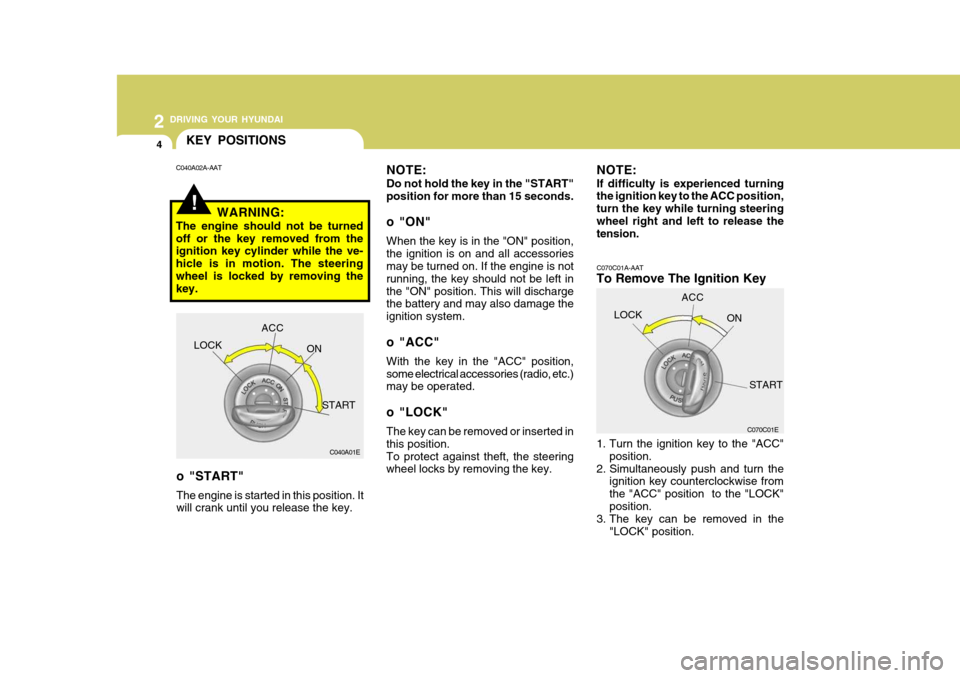
2 DRIVING YOUR HYUNDAI
4
!
C040A01E
KEY POSITIONS
C070C01A-AAT
To Remove The Ignition Key
1. Turn the ignition key to the "ACC"position.
2. Simultaneously push and turn the ignition key counterclockwise from the "ACC" position to the "LOCK"position.
3. The key can be removed in the
"LOCK" position.
NOTE: Do not hold the key in the "START" position for more than 15 seconds.
o "ON" When the key is in the "ON" position, the ignition is on and all accessories may be turned on. If the engine is not running, the key should not be left inthe "ON" position. This will discharge the battery and may also damage the ignition system.
o "ACC" With the key in the "ACC" position, some electrical accessories (radio, etc.) may be operated.
o "LOCK" The key can be removed or inserted in this position.To protect against theft, the steering wheel locks by removing the key.
C040A02A-AAT
WARNING:
The engine should not be turned off or the key removed from the ignition key cylinder while the ve- hicle is in motion. The steeringwheel is locked by removing the key.
LOCK ACC
ON
START C070C01E
LOCK
ACC
ON
START
o "START" The engine is started in this position. It will crank until you release the key. NOTE: If difficulty is experienced turning the ignition key to the ACC position, turn the key while turning steeringwheel right and left to release the tension.
Page 132 of 232
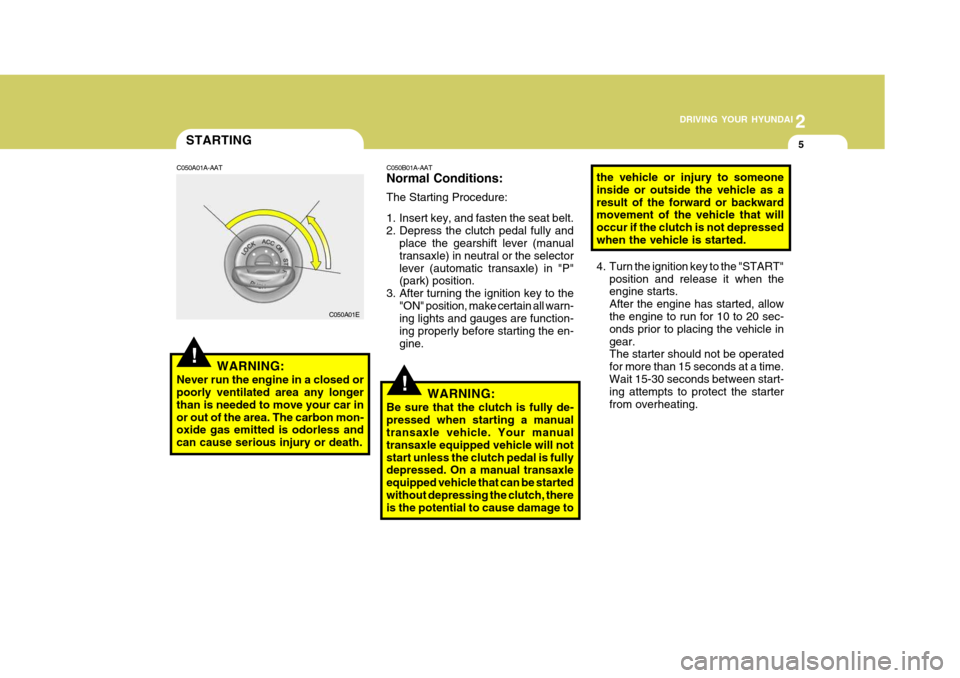
2
DRIVING YOUR HYUNDAI
5
2
DRIVING YOUR HYUNDAI
5
!
!
STARTING
C050A01A-AAT
WARNING:
Never run the engine in a closed or poorly ventilated area any longer than is needed to move your car inor out of the area. The carbon mon- oxide gas emitted is odorless and can cause serious injury or death. C050B01A-AAT Normal Conditions: The Starting Procedure:
1. Insert key, and fasten the seat belt.
2. Depress the clutch pedal fully and
place the gearshift lever (manualtransaxle) in neutral or the selectorlever (automatic transaxle) in "P" (park) position.
3. After turning the ignition key to the "ON" position, make certain all warn-ing lights and gauges are function- ing properly before starting the en-gine.
WARNING:
Be sure that the clutch is fully de-pressed when starting a manual transaxle vehicle. Your manual transaxle equipped vehicle will notstart unless the clutch pedal is fully depressed. On a manual transaxle equipped vehicle that can be startedwithout depressing the clutch, there is the potential to cause damage to the vehicle or injury to someone inside or outside the vehicle as aresult of the forward or backward movement of the vehicle that will occur if the clutch is not depressedwhen the vehicle is started.
4. Turn the ignition key to the "START"
position and release it when the engine starts. After the engine has started, allowthe engine to run for 10 to 20 sec- onds prior to placing the vehicle in gear. The starter should not be operated for more than 15 seconds at a time.Wait 15-30 seconds between start- ing attempts to protect the starter from overheating.
C050A01E
Page 133 of 232
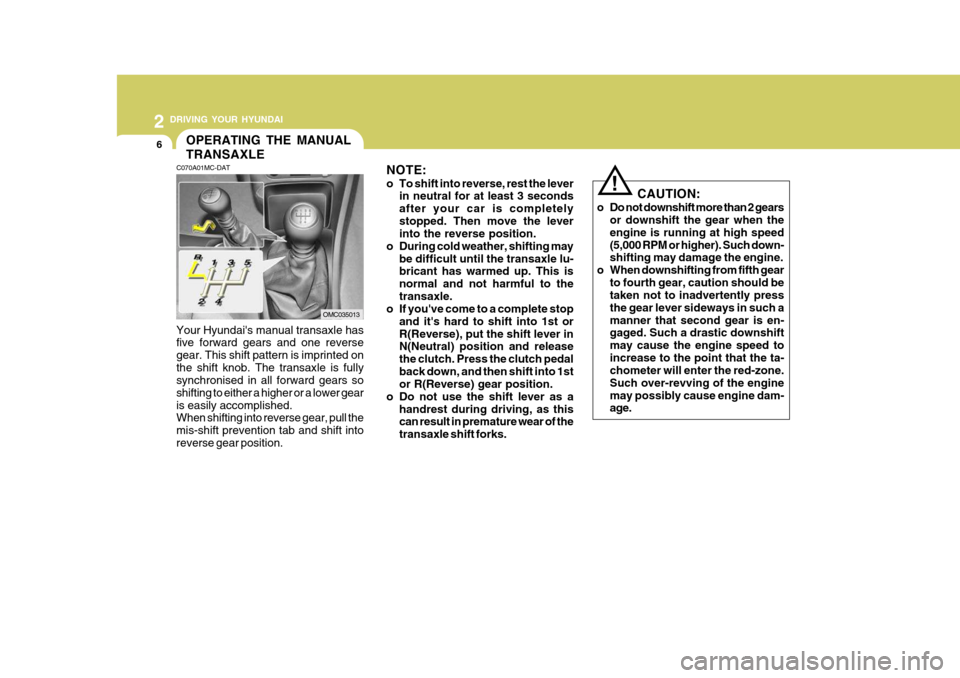
2 DRIVING YOUR HYUNDAI
6OPERATING THE MANUAL TRANSAXLE
NOTE:
o To shift into reverse, rest the leverin neutral for at least 3 seconds after your car is completelystopped. Then move the lever into the reverse position.
o During cold weather, shifting may be difficult until the transaxle lu-bricant has warmed up. This is normal and not harmful to thetransaxle.
o If you've come to a complete stop
and it's hard to shift into 1st orR(Reverse), put the shift lever in N(Neutral) position and release the clutch. Press the clutch pedalback down, and then shift into 1st or R(Reverse) gear position.
o Do not use the shift lever as a handrest during driving, as thiscan result in premature wear of the transaxle shift forks. CAUTION:
o Do not downshift more than 2 gears or downshift the gear when theengine is running at high speed(5,000 RPM or higher). Such down- shifting may damage the engine.
o When downshifting from fifth gear to fourth gear, caution should betaken not to inadvertently press the gear lever sideways in such amanner that second gear is en- gaged. Such a drastic downshift may cause the engine speed toincrease to the point that the ta- chometer will enter the red-zone. Such over-revving of the enginemay possibly cause engine dam- age.
!
C070A01MC-DAT Your Hyundai's manual transaxle has five forward gears and one reverse gear. This shift pattern is imprinted onthe shift knob. The transaxle is fully synchronised in all forward gears so shifting to either a higher or a lower gearis easily accomplished. When shifting into reverse gear, pull the mis-shift prevention tab and shift intoreverse gear position.
OMC035013
Page 134 of 232

2
DRIVING YOUR HYUNDAI
7
2
DRIVING YOUR HYUNDAI
7
C070D02O-AAT Good Driving Practices
o Never take the car out of gear and coast down a hill. This is extremely hazardous. Always leave the car in gear.
o Don't "ride" the brakes. This can cause them to overheat and mal-function. Instead, when you are driv- ing down a long hill, slow down andshift to a lower gear. When you do this, engine braking will help slow the car.
o Slow down before shifting to a lower gear. This will help avoid over-rev-ving the engine, which can causedamage.
o Slow down when you encounter
cross winds. This gives you muchbetter control of your car.
o Be sure the car is completely stopped
before you attempt to shift into re-verse. The transaxle can be dam- aged if you do not. To shift into reverse, depress the clutch, movethe shift lever to neutral, wait three seconds, then shift to the reverse position.
o Exercise extreme caution when driving on a slippery surface. Beespecially careful when braking,
C070E03A-DAT RECOMMENDED SHIFT POINTS
1-2 2-33-4 4-5
Shift
from-to Recommended
20 km/h 40 km/h 55 km/h 75 km/h
The shift points as shown above are recommended for optimum fuel economy and performance.
C070B01A-DAT Using the Clutch The clutch should be pressed all the way to the floor before shifting, thenreleased slowly. The clutch pedal should fully return to the original posi- tion. Do not rest your foot on the clutchpedal while driving. This can cause unnecessary wear. Do not partially engage the clutch to hold the car on anincline. This causes unnecessary wear. Use the hand brake to hold the car on an incline. Do not operate the clutchpedal rapidly and repeatedly.
Page 135 of 232
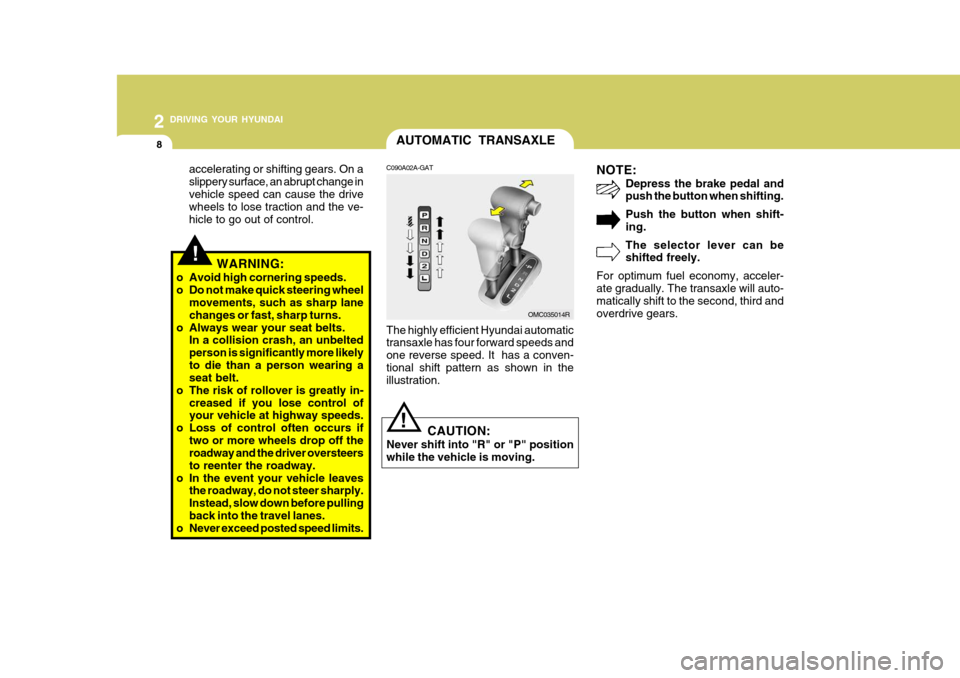
2 DRIVING YOUR HYUNDAI
8
!
AUTOMATIC TRANSAXLE
NOTE:Depress the brake pedal and push the button when shifting. Push the button when shift- ing. The selector lever can be shifted freely.
For optimum fuel economy, acceler-ate gradually. The transaxle will auto- matically shift to the second, third andoverdrive gears.
C090A02A-GAT
The highly efficient Hyundai automatic transaxle has four forward speeds and one reverse speed. It has a conven-tional shift pattern as shown in the illustration. CAUTION:
Never shift into "R" or "P" position while the vehicle is moving.
accelerating or shifting gears. On aslippery surface, an abrupt change invehicle speed can cause the drive wheels to lose traction and the ve- hicle to go out of control.
WARNING:
o Avoid high cornering speeds.
o Do not make quick steering wheel movements, such as sharp lanechanges or fast, sharp turns.
o Always wear your seat belts. In a collision crash, an unbeltedperson is significantly more likelyto die than a person wearing a seat belt.
o The risk of rollover is greatly in- creased if you lose control ofyour vehicle at highway speeds.
o Loss of control often occurs if two or more wheels drop off theroadway and the driver oversteers to reenter the roadway.
o In the event your vehicle leaves the roadway, do not steer sharply.Instead, slow down before pullingback into the travel lanes.
o Never exceed posted speed limits.
OMC035014R
!
Page 136 of 232

2
DRIVING YOUR HYUNDAI
9
2
DRIVING YOUR HYUNDAI
9
C090B01A-DAT The Function of Each Position Is As Follows: o P (Park): Use to hold the vehicle in place when parking or while starting the engine. Whenever parking the car, apply the hand brake and shift the selector leverto the "P" (Park) position.
! CAUTION:
Never place the selector lever in the "P" (Park) position unless the ve-hicle is fully stopped. Failure to observe this caution will cause se- vere damage to the transaxle. C090C01A-AAT o R(Reverse): Use for backing up the vehicle. Bring the car to a complete stop before shift-ing the selector lever to "R" position. C090D02A-AAT o N (Neutral): In the "N" position, the transaxle is in neutral, which means that no gears are engaged. The engine can be startedwith the shift lever in "N" position, although this is not recommended ex- cept if the engine stalls while the car ismoving.
C090F01A-AAT o 2 (Second gear): Use for driving on a slippery road, hill climbing or engine braking downhill."2" automatically shifts between first and second gears. This means that no shift-up to 3rd gearis performed. However, the shift-up to third gear is done when the car speed exceeds a certain value to prevent the
engine from over-revving. Manually move the selector to "D" returning to normal driving condition.
C090E02A-GAT o D (Drive): Use for normal driving. Bring the car to a complete stop before shifting the selector to "D" position. The transaxle will automatically shift through a four-gear sequence. Never downshift manu- ally to "2" position or "L" position when vehicle speed is more than 95 km/h (60mph). C090G01A-GAT o L (Low gear): Use for driving up a very steep grade or for engine braking when descendingsteep hills. When downshifting to "L", the transaxle will temporarily remain in second gear until the vehicle hasslowed enough for low gear to engage. Do not exceed 50 km/h (30 mph) in low gear.
Page 137 of 232

2 DRIVING YOUR HYUNDAI
10
C090P01A-GAT Overdrive Switch
When the overdrive switch is turned on, the transaxle will automatically upshift to the second, third and overdrive gears.When the overdrive switch is turned off,
the transaxle will not upshift to the over- drive gear. For normal driving, the selec-tor lever should be left in the "D" position
and the overdrive switch turned on. If you need to accelerate rapidly, pressthe accelerator pedal all the way to the floor. The transaxle will automatically shift to a lower gear, depending on thevehicle speed and load.
C090I02MC-DAT
!
CAUTION:
o Shift into "R", "D" and "P" posi- tion only when the vehicle has completely stopped.
o Do not accelerate the engine in
reverse or any of the forwardpositions with the brakes applied.
o Always apply the footbrake when shifting from "P" or "N", to "R","D", "2" or "L" position.
o Do not use the "P" (Park) posi- tion in place of the hand brake.Always set the hand brake, shift the transaxle into "P" (Park) po-sition and turn off the ignition when you leave the vehicle, even momentarily. Never leave the ve-hicle unattended while the en- gine is running.
o When accelerating from a stop on a steep hill, the vehicle may havea tendency to roll backwards. Shift- ing the shift lever into 2nd gearwill help prevent the vehicle from rolling backwards.
o Check the automatic transaxle fluid level regularly, and add fluid asnecessary.
C090H01A-DAT NOTE:
o For smooth and safe operation,
depress the brake pedal when shifting from "Neutral" position or "Park" position to a forward or reverse gear.
o The ignition key must be in the "ON" position and the brake pedalfully depressed in order to movethe shift lever from the "P" (Park) position to any of the other posi- tions.
o It is always possible to shift from "R", "N", "D", "2", L" position to"P" position. The vehicle mustbe fully stopped to avoid transaxle damage.
OMC035016R
o See the maintenance schedule for
the proper fluid recommendation.
E060103AUN Ignition key interlock system (If Installed) The ignition key cannot be removed unless the shift lever is in the P (Park)position. If the ignition switch is in any other position, the key cannot be re- moved.
Page 138 of 232
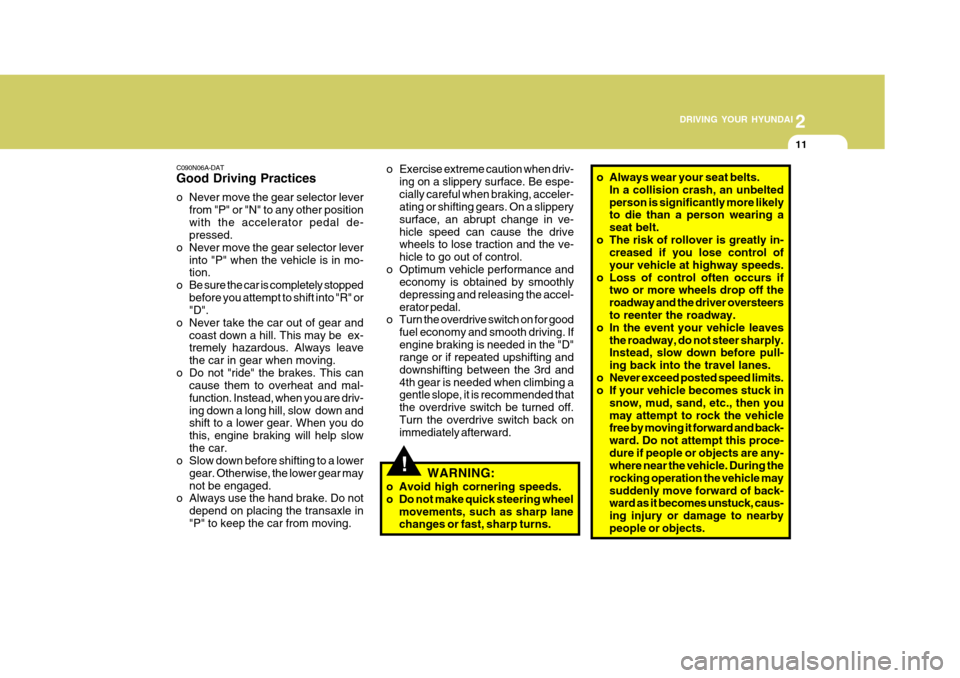
2
DRIVING YOUR HYUNDAI
11
2
DRIVING YOUR HYUNDAI
11
!
C090N06A-DAT Good Driving Practices
o Never move the gear selector lever
from "P" or "N" to any other position with the accelerator pedal de- pressed.
o Never move the gear selector lever into "P" when the vehicle is in mo-tion.
o Be sure the car is completely stopped before you attempt to shift into "R" or"D".
o Never take the car out of gear and coast down a hill. This may be ex-tremely hazardous. Always leave the car in gear when moving.
o Do not "ride" the brakes. This can cause them to overheat and mal-function. Instead, when you are driv-ing down a long hill, slow down and shift to a lower gear. When you do this, engine braking will help slowthe car.
o Slow down before shifting to a lower
gear. Otherwise, the lower gear maynot be engaged.
o Always use the hand brake. Do not
depend on placing the transaxle in"P" to keep the car from moving. o Exercise extreme caution when driv-
ing on a slippery surface. Be espe-cially careful when braking, acceler- ating or shifting gears. On a slippery surface, an abrupt change in ve-hicle speed can cause the drive wheels to lose traction and the ve- hicle to go out of control.
o Optimum vehicle performance and economy is obtained by smoothlydepressing and releasing the accel-erator pedal.
o Turn the overdrive switch on for good
fuel economy and smooth driving. Ifengine braking is needed in the "D" range or if repeated upshifting and downshifting between the 3rd and4th gear is needed when climbing a gentle slope, it is recommended that the overdrive switch be turned off.Turn the overdrive switch back on immediately afterward.
WARNING:
o Avoid high cornering speeds.
o Do not make quick steering wheel movements, such as sharp lane changes or fast, sharp turns. o Always wear your seat belts.
In a collision crash, an unbelted person is significantly more likely to die than a person wearing a seat belt.
o The risk of rollover is greatly in- creased if you lose control ofyour vehicle at highway speeds.
o Loss of control often occurs if two or more wheels drop off theroadway and the driver oversteersto reenter the roadway.
o In the event your vehicle leaves
the roadway, do not steer sharply. Instead, slow down before pull- ing back into the travel lanes.
o Never exceed posted speed limits.
o If your vehicle becomes stuck in snow, mud, sand, etc., then you may attempt to rock the vehicle free by moving it forward and back- ward. Do not attempt this proce-dure if people or objects are any- where near the vehicle. During the rocking operation the vehicle maysuddenly move forward of back- ward as it becomes unstuck, caus- ing injury or damage to nearbypeople or objects.
Page 139 of 232
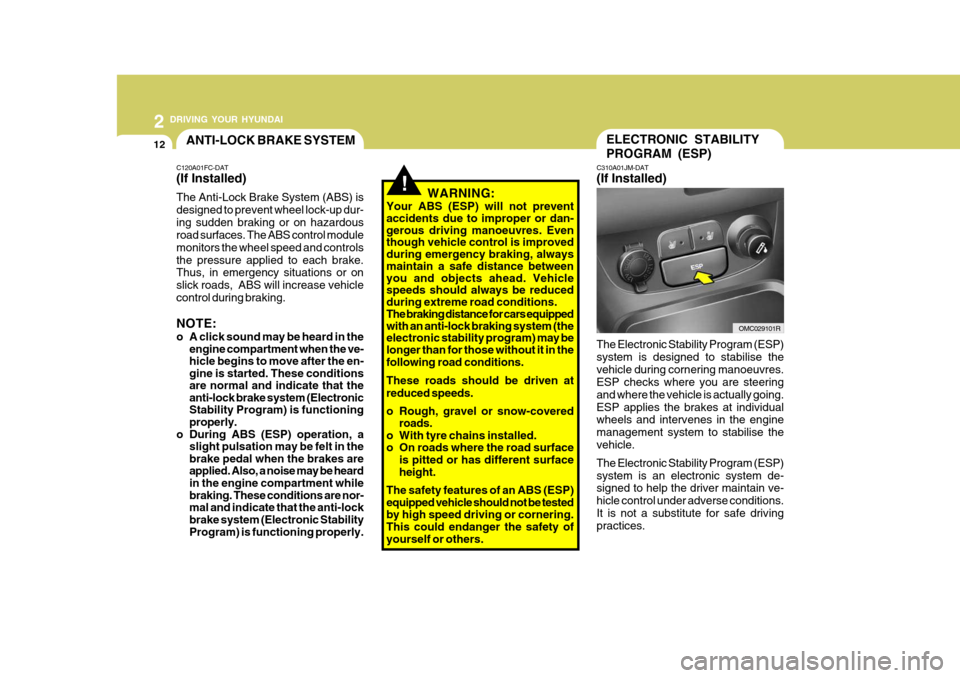
2 DRIVING YOUR HYUNDAI
12ANTI-LOCK BRAKE SYSTEMELECTRONIC STABILITY PROGRAM (ESP)
C310A01JM-DAT (If Installed)
OMC029101R
The Electronic Stability Program (ESP) system is designed to stabilise thevehicle during cornering manoeuvres. ESP checks where you are steering and where the vehicle is actually going.ESP applies the brakes at individual wheels and intervenes in the engine management system to stabilise thevehicle. The Electronic Stability Program (ESP) system is an electronic system de- signed to help the driver maintain ve- hicle control under adverse conditions.It is not a substitute for safe driving practices.
!WARNING:
Your ABS (ESP) will not prevent accidents due to improper or dan- gerous driving manoeuvres. Even though vehicle control is improved during emergency braking, always maintain a safe distance between you and objects ahead. Vehicle speeds should always be reduced during extreme road conditions. The braking distance for cars equipped
with an anti-lock braking system (the
electronic stability program) may be
longer than for those without it in the following road conditions. These roads should be driven at reduced speeds.
o Rough, gravel or snow-covered
roads.
o With tyre chains installed.
o On roads where the road surface is pitted or has different surface height.
The safety features of an ABS (ESP) equipped vehicle should not be testedby high speed driving or cornering.This could endanger the safety of yourself or others.
C120A01FC-DAT(If Installed) The Anti-Lock Brake System (ABS) is designed to prevent wheel lock-up dur-ing sudden braking or on hazardous road surfaces. The ABS control module monitors the wheel speed and controlsthe pressure applied to each brake. Thus, in emergency situations or on slick roads, ABS will increase vehiclecontrol during braking. NOTE:
o A click sound may be heard in the
engine compartment when the ve- hicle begins to move after the en-gine is started. These conditionsare normal and indicate that theanti-lock brake system (ElectronicStability Program) is functioning properly.
o During ABS (ESP) operation, a slight pulsation may be felt in the brake pedal when the brakes areapplied. Also, a noise may be heardin the engine compartment while braking. These conditions are nor- mal and indicate that the anti-lockbrake system (Electronic Stability Program) is functioning properly.
Page 140 of 232

2
DRIVING YOUR HYUNDAI
13
2
DRIVING YOUR HYUNDAI
13
C310B01JM-AAT ESP ON/OFF Mode When the ESP is operating, the ESP indicator in the instrument cluster willblink. If you turn the system off by pressing the ESP switch, the ESP-OFF indica-tor will come on and stay on. In the ESP-OFF mode, the stability control will be deactivated. Adjust your drivingaccordingly. To turn the system back on, press the switch again. The ESP- OFF indicator should go off. NOTE: The ESP mode will automatically be turned ON after the engine is turnedoff and restarted. C310D01JM-DAT Indicators and Warning The indicators should illuminate when the ignition key is turned to ON orSTART but should go out after three seconds. If the indicators do not illuminate, or theESP or ESP-OFF indicator does not go out after 3 seconds, have the vehicle checked by an authorised dealer. Should there be any unusual conditions in the device while driving, ESP-OFFindicator illuminates as a warning. If ESP-OFF indicator illuminates, pull your car to a safe place and stop theengine. Then, start the engine again to check if the ESP-OFF indicator goes out. If the indicator remains lit even after the engine has been started, have your carchecked by an authorised Hyundai dealer.
!
CAUTION:
Driving with varying tyre or wheel size may cause the ESP system tomalfunction. When replacing tyres, make sure they are the same size as your original tyres.!
Factors including speed, road condi- tions and driver steering input can allaffect whether ESP will be effective in preventing a loss of control. It is still your responsibility to drive and cornerat reasonable speeds and to leave a sufficient margin of safety.
WARNING:
Electronic stability program is only a driving aid; all normal precautions for driving in bad weather and on slippery road surfaces should beobserved.